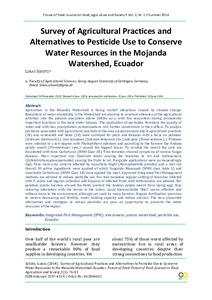| dc.date.accessioned | 2014-06-26T12:18:24Z | |
| dc.date.available | 2014-06-26T12:18:24Z | |
| dc.date.issued | 2014-06-10 | |
| dc.identifier.issn | 2197-411X | |
| dc.identifier.uri | urn:nbn:de:hebis:34-2014062645593 | |
| dc.identifier.uri | http://hdl.handle.net/123456789/2014062645593 | |
| dc.language.iso | eng | |
| dc.publisher | Department of Organic Food Quality and Food Culture at the University of Kassel, Germany and Federation of German Scientists (VDW) | eng |
| dc.rights | Urheberrechtlich geschützt | |
| dc.rights.uri | https://rightsstatements.org/page/InC/1.0/ | |
| dc.subject | Integrated Pest Management (IPM) | eng |
| dc.subject | tree tomato | eng |
| dc.subject | potato | eng |
| dc.subject | watershed | eng |
| dc.subject | pesticide use | eng |
| dc.subject | Ecuador | eng |
| dc.subject.ddc | 630 | |
| dc.title | Survey of Agricultural Practices and Alternatives to Pesticide Use to Conserve Water Resources in the Mojanda Watershed, Ecuador | eng |
| dc.type | Aufsatz | |
| dcterms.abstract | Agriculture in the Mojanda Watershed is facing rainfall reductions caused by climate change. Reductions of water availability in the Watershed are also due to constant extension of the agricultural activities into the páramo ecosystem above 3000m a.s.l., with this ecosystem having immanently important functions in the local water balance. The application of pesticides threatens the quality of water and with less precipitation contaminations will further concentrate in the outflow. To analyze problems associated with agricultural practices in the area a questionnaire about agricultural practices (28) was conducted and fields (20) were surveyed for pests and diseases with a focus on potatoes (Solanum tuberosum L.), tree tomatoes (Solanum betaceum Cav.) and peas (Pisum sativum L.). Potatoes were infected to a low degree with Phytophthora infestans and according to the farmers the Andean potato weevil (Premnotrypes spec.) caused biggest losses. To combat the weevil the soils are disinfected with toxic Carbofuran (WHO Class 1B). Tree tomatoes showed symptoms of various fungal diseases. Most important was Fusarium solani causing the branches to rot and Anthracnosis (Colletotrichum gloeosporioides) causing the fruits to rot. Fungicide applications were correspondingly high. Peas were only minorly affected by Ascochyta blight (Mycosphaerella pinodes) and a root rot. Overall 19 active ingredients were applied of which fungicide Mancozeb (WHO class table 5) and insecticide Carbofuran (WHO Class 1B) were applied the most. Approved IPM methods are advised to reduce pesticide use. For tree tomatoes regular cutting of branches infected with F. solani and regular collection and disposal of infected fruits with Anthracnosis are advised. For potatoes plastic barriers around the fields prevent the Andean potato weevil from laying eggs thus reducing infestation with the larvae in the tubers. Local bioinsecticide “Biol” seems effective and without harm to the environment, although not used by many farmers. Organic fertilization promises to restore decreasing soil fertility, water holding capacity and reduce erosion. The here presented alternatives and strategies to reduce pesticide use pose an opportunity to preserve the water resources of the region. | eng |
| dcterms.accessRights | open access | |
| dcterms.bibliographicCitation | In: Future of Food: Journal on Food, Agriculture and Society. Witzenhausen : University of Kassel, Department of Organic Food Quality and Food Culture. - Vol. 2, No. 1 (2014), S. 76-92 | |
| dcterms.creator | Schütz, Lukas | |

